Annapurna Base Camp Trek Difficulty- Annapurna Base Camp Trek is a popular and relatively easy trekking route in Nepal that offers breathtaking views of the Himalayan mountain range. The trek takes you through diverse landscapes from lush forests to barren high-altitude terrain and offers a chance to witness the unique culture and lifestyles of the local people. The trek typically starts and ends in the city of Pokhara, which is located about 200 kilometers west of Kathmandu which is the capital of Nepal.
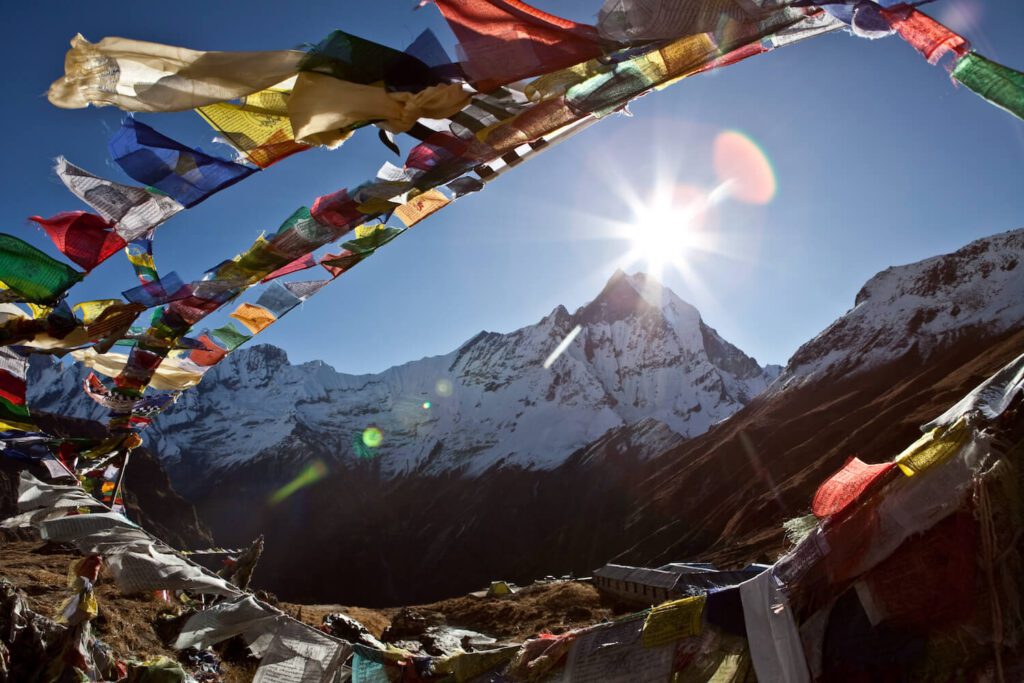
The trail takes you through the beautiful Modi Khola valley and passes through several traditional Gurung and Magar villages where you can experience their hospitality and sample local food. The highlight of the trek is reaching the Annapurna Base Camp, which is at an altitude of 4,130 meters above sea level. The panoramic view of the Annapurna massif, Dhaulagiri, Machhapuchhre, and other peaks from the base camp is truly awe-inspiring.
Annapurna Base Camp for Beginners
A beginner can attempt the Annapurna Base Camp trek with proper preparation and guidance. The trek does not require any technical climbing skills and the trail is well-marked and well-maintained. It is recommended that beginners start with shorter treks to acclimatize to the altitude and build up their fitness level before attempting longer and more challenging treks like Annapurna Base Camp. It’s also essential to consult a doctor before embarking on any trekking adventure to ensure you’re physically fit to undertake the journey.
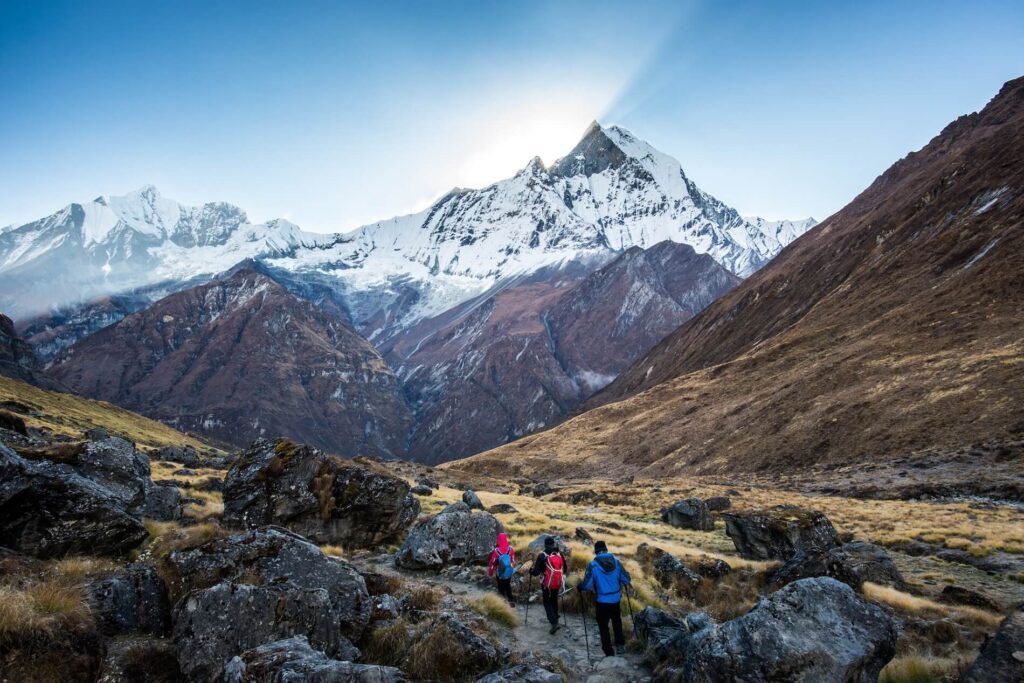
Having a knowledgeable and experienced guide can also make a significant difference in the safety and success of the trek. The guide can provide valuable information about the trail, culture, and terrain and help you acclimatize to the altitude. Additionally, it’s crucial to carry appropriate gear and clothing, stay hydrated, and listen to your body.
Solo Trek to Annapurna Base Camp Trek Difficulty
It is possible to trek solo to Annapurna Base Camp. However, it is important to note that trekking in a group or with a guide is generally recommended for safety reasons. Trekking solo can be risky, especially if you are not familiar with the terrain, weather, and local customs.
Also Read: Annapurna Base Camp in January
If you have experience trekking in the Himalayas and are well-prepared with the proper gear, permits, and a well-planned itinerary, trekking solo to Annapurna Base Camp can be a rewarding experience. Make sure to research the route thoroughly, carry enough supplies, and take necessary precautions to ensure your safety along the way. It is also a good idea to let someone know your itinerary and expected return date before setting off.
Annapurna Base Camp Trek Difficulty Level
Although the Annapurna Base Camp trek is a well-liked hiking route situated in Nepal’s Annapurna region and is generally feasible and appropriate for most hikers there are various challenges that you could confront during the trek. The Difficulty level of the Annapurna Base Camp Trek is Moderate.
Some of the Annapurna Base Camp Difficulties that you can face:
Altitude sickness is one of the most Moderate + Demanding:
Altitude sickness, also known as acute mountain sickness (AMS), is a common problem that occurs when ascending to high altitudes. Annapurna Base Camp Trek is a popular trekking destination in Nepal. It takes you to a height of 4,130 meters, making it an excellent location to experience the difficulties caused by altitude sickness. Altitude sickness can affect anyone regardless of age, fitness level, or previous trekking experience.

Symptoms of altitude sickness include headaches, nausea, vomiting, dizziness, fatigue, loss of appetite, shortness of breath, and insomnia. During the Annapurna Base Camp Trek, the higher you go the thinner the air becomes.
This decrease in air pressure and oxygen levels can cause altitude sickness. The risk of developing altitude sickness increases with the rate of ascent and the elevation gained. Therefore, it is essential to follow a gradual acclimatization process during the trek. The Annapurna Base Camp Trek has several altitude gain stages, increasing the risk of altitude sickness.
Weather conditions are also a main Difficulty at Annapurna Base Camp:
Weather conditions are one of the significant challenges that trekkers face during the Annapurna Base Camp Trek. The weather in the Annapurna region can be unpredictable and it can change quickly from sunny and warm to cold and rainy or even snowy. Here are some of the difficulties caused by weather conditions during the Annapurna Base Camp Trek.
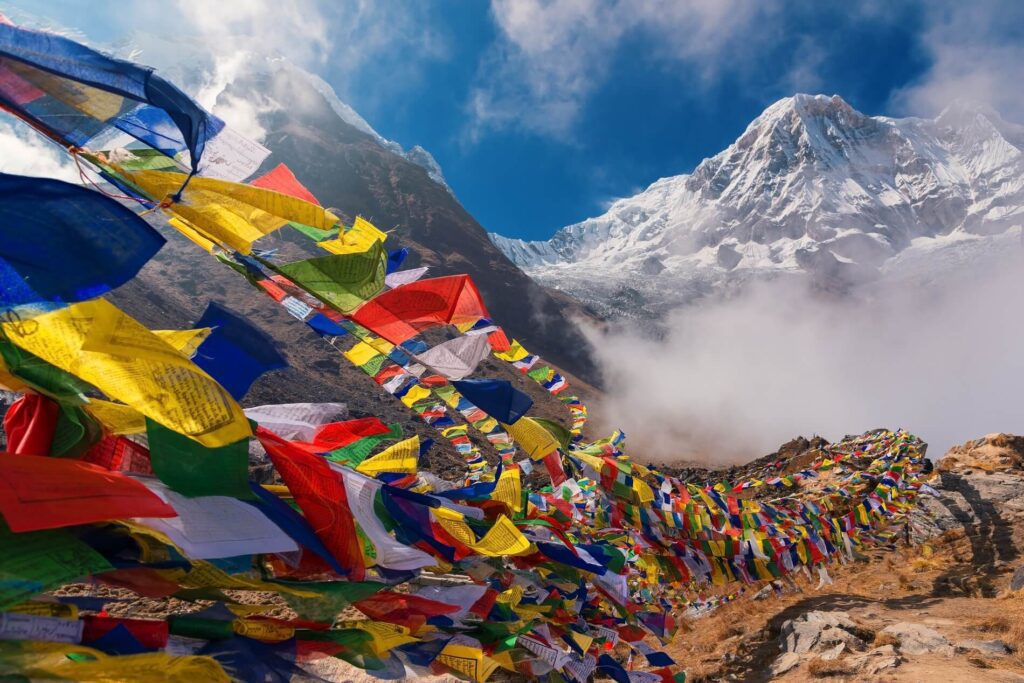
The Annapurna region experiences rain and snow during the monsoon and winter seasons. The monsoon season in Nepal is from June to August and it is the wettest time of the year. During this season, trekking in the Annapurna region can be challenging due to the heavy rain and muddy trails. In the winter season, from December to February, the temperature drops significantly and it can snow at higher altitudes. Snow can make the trekking trail slippery and difficult to walk on.
Strong winds make it challenging
The Annapurna region is known for its strong winds, especially at higher altitudes. Strong winds can make it challenging to walk on the trekking trail and they can also cause altitude sickness. It is essential to take proper precautions and acclimatize before trekking to higher altitudes.
The weather in the Annapurna region can change quickly and it can reduce visibility. Fog and clouds can obstruct the view of the beautiful mountain ranges which can be disappointing for trekkers who have come to see the magnificent scenery. It is essential to plan the trek accordingly and be flexible with the schedule to avoid missing out on the views.
Challenging terrain:
The most difficult parts of the Annapurna Base Camp Trek include steep ascents and descents. The trekking route requires thousands of steps up and down which can be stressful on the knees and legs. It might be challenging to walk on a rough and uneven walking track. To prevent sliding or falling, it’s crucial to use caution when walking on rough paths. The rough pathways might be painful for the feet.
Popular: Top 10 Trekking Places in Nepal
Narrow Bridges:
The Annapurna region has several suspension bridges that cross over deep gorges and rivers. The bridges are narrow and the movement can be unsettling for some trekkers. It is important to be cautious while crossing the bridges and hold onto the railings for support.
Accommodation and facilities:
The Annapurna Base Camp trip is a well-known trekking route in Nepal that draws thousands of tourists each year. While the journey is a must-do for outdoor enthusiasts and offers breathtaking vistas of the Himalayas, there are certain challenges that trekkers may run into owing to accommodations and facilities along the way. The low supply of lodging during the busiest trekking season is one of the biggest problems hikers encounter. Due to its popularity, there may not be enough places to stay when the Annapurna Base Camp trip is being undertaken.
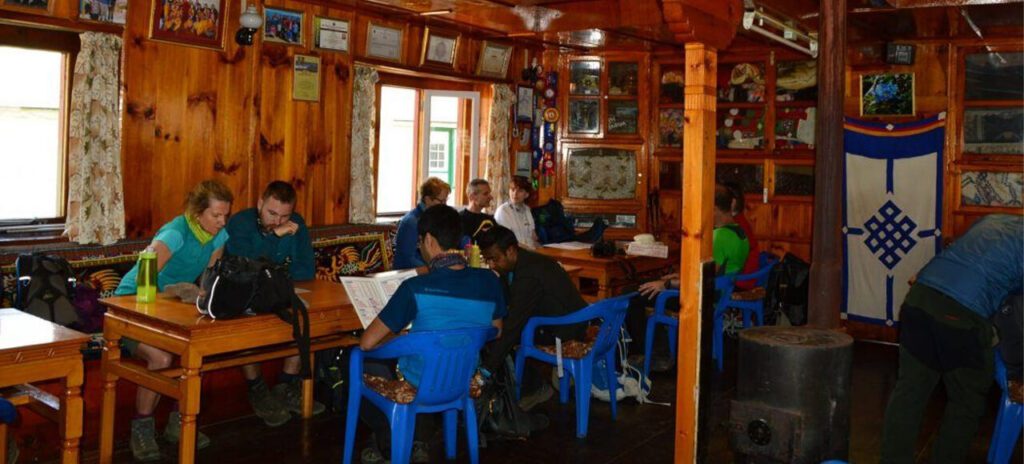
To locate a decent place to stay, hikers might have to trek for a long time or choose an inadequate alternative. Another difficulty is the lack of basic facilities such as clean water and proper toilets. Due to the high altitude and remoteness of the trek, it can be challenging to find clean drinking water. Trekkers may have to rely on bottled water which can be expensive and not environmentally friendly. Similarly, toilets are often basic and not up to Western standards, which can be uncomfortable for some trekkers.
Cost:
Accommodation is one of the highest costs during the Annapurna Base Camp trek. As you move higher in the mountains, the cost of accommodation increases and the quality of the facilities decreases. During peak season, finding a place to stay can also be a challenge and you may end up paying more than the usual rate.
As you ascend further into the mountains during the Annapurna Base Camp trek you’ll notice an increase in the cost of food and drinks. Since the trek is based on tea house lodges you’ll be dining at the available accommodations along the route. The prices for food and drinks are usually higher than in Kathmandu and the range of food options also can be limited.

Getting to the starting point of the Annapurna Base Camp trek can also be costly especially if you’re coming from Kathmandu. You’ll need to take a bus or a jeep to get to Pokhara, the gateway to the trek, and then take another jeep or taxi to Nayapul the starting point of the trek. Hiring a guide or a porter can be expensive during the Annapurna Base Camp trek but it’s highly recommended.
A guide can help you navigate the trail, communicate with the locals and ensure your safety while a porter can carry your heavy backpack leaving you free to enjoy the scenery. However, the cost of hiring a guide or a porter can add up quickly especially if you’re trekking solo.
Communication difficulties:
One of the primary difficulties faced by trekkers during the Annapurna Base Camp trek is the language barrier. Most of the locals in the region speak Nepali or one of the local dialects which can make it challenging for non-native speakers to communicate effectively. Moreover, the accent and pronunciation of the locals may differ significantly from what trekkers are used to which can further complicate communication.
Another challenge is the lack of reliable communication infrastructure in the region. While some tea houses along the trail may offer Wi-Fi, the signal strength is often weak and unreliable. Similarly, mobile network coverage is spotty, and trekkers may find it challenging to make phone calls or access the internet, especially in remote areas.
Navigational Difficulties
Navigational difficulties can also arise due to communication challenges. While the trail is generally well-marked, trekkers may need to ask locals for directions, which can be difficult if they cannot communicate effectively. Additionally, weather conditions can change quickly in the mountains, making it crucial to have accurate and up-to-date information on trail conditions which can be challenging to obtain without reliable communication.
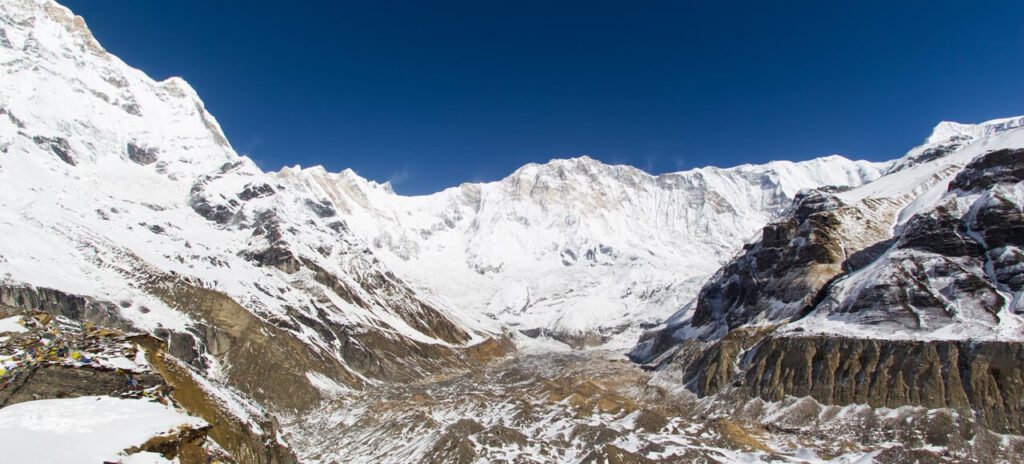
Remote region:
The availability of basic supplies such as food and medicines may also be limited, making it essential for trekkers to carry adequate provisions with them. Another challenge posed by the remote region is the risk of altitude sickness. The Annapurna Base Camp trek reaches a maximum altitude of over 4,000 meters, which can lead to altitude-related illnesses such as Acute Mountain Sickness (AMS).
Since medical facilities are limited in the remote region it is crucial for trekkers to acclimatize properly, stay hydrated, and seek medical attention if they experience any symptoms of AMS. The remote region can also make it challenging to obtain help in case of emergencies.
Trekkers may have to walk for several hours or even days to reach the nearest medical facility or rescue center making it crucial to have a well-equipped first aid kit and emergency communication devices such as a satellite phone.
Luggage Management:
The managing of luggage is one of the biggest challenges that trekkers encounter. Most of the flights from Kathmandu to Pokhara, the starting point of the trek have a strict weight limit for baggage. Trekkers are allowed to carry only 15-20 kgs of luggage including their trekking gear and personal belongings. This weight limit can be a challenge for those who have a lot of luggage or are carrying bulky items.
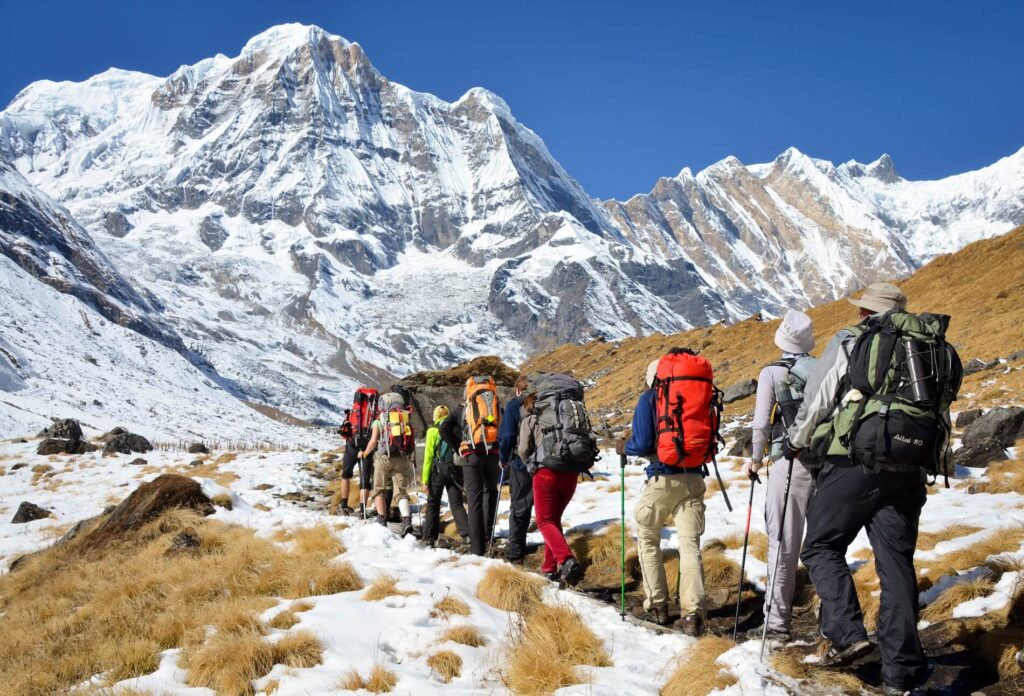
The Annapurna Base Camp trek requires trekking for several days, and carrying heavy luggage can be exhausting. Many trekkers choose to hire a porter to carry their luggage. However, during peak seasons it can be challenging to find a porter as they get booked up quickly. The trails during the Annapurna Base Camp trek are narrow and winding, with steep ascents and descents.
Carrying heavy luggage can be a significant challenge, especially during steep uphill climbs. This can slow down the trekking pace and make the trek more challenging. During the trek, trekkers stay in teahouses which are basic lodges that provide accommodation and meals. These teahouses have limited storage space and carrying excess luggage can be a problem. Trekkers may have to leave their excess luggage at the teahouses which can be inconvenient and may result in additional costs.
Also Check: Food and Accommodation on Everest Base Camp Trek
Trek Permit is also Annapurna Base Camp Trek Difficulty:
The Annapurna Conservation Area Project (ACAP) has set up a trekking permit system to regulate the number of visitors, which can cause difficulties for trekkers. The Annapurna Base Camp (ABC) trek requires a TIMS (Trekkers’ Information Management System) card and an ACAP permit. These permits can be obtained from the Nepal Tourism Board in Kathmandu or Pokhara. However, obtaining the permits can be a tedious and time-consuming process.

If you are trekking with a trekking agency, they usually handle the permit process but if you are trekking independently you will have to obtain the permits yourself. Another difficulty is the paperwork and bureaucracy involved in obtaining the permits. You need to provide various documents including your passport, visa, and a passport-sized photo which can be time-consuming and challenging for trekkers who are short on time.
Moreover, the permit system can cause delays in the trek. During the peak season, there can be long queues at the permit office and it can take several hours to obtain the permits. This delay can be frustrating for trekkers who want to start their trek early and reach their destination before sunset.
Tips for Annapurna Base Camp Trek
Annapurna Base Camp Trek is one of the most popular and stunning trekking destinations in Nepal. It is a perfect blend of natural beauty, cultural exploration, and challenging trekking trails. Here are some tips to help you prepare for your Annapurna Base Camp Trek:
Physical Preparation:
The Annapurna Base Camp Trek is a moderate to challenging level trek, and it is essential to prepare yourself physically before embarking on the journey. Start with some cardio exercises like running, cycling, or swimming to improve your endurance. Additionally, practice trekking on hills and mountains to get used to the terrain.
Choose the right time:
The best time to go for the Annapurna Base Camp Trek is from March to May and September to November. During these months, the weather is usually pleasant and stable making the trek more comfortable.
Choose the right gear:
Invest in proper trekking gear including comfortable trekking shoes, pants, and warm clothes, especially for the nighttime. Additionally, carry a good-quality sleeping bag, trekking poles, and a waterproof backpack. You should also bring a first-aid kit, water bottles, and snacks.
Acclimatization:
Annapurna Base Camp Trek includes gaining altitude and it is essential to acclimatize properly to avoid altitude sickness. Take enough rest days, stay hydrated, and avoid alcohol and smoking during the trek.
Carry sufficient cash:
There are no ATMs or money exchanges after reaching the trekking route. Carry enough cash to cover your expenses during the trek including food, accommodation, and transportation.
Stay Hydrated:
Hydration is essential during the trek as it helps in acclimatization and prevents altitude sickness. Carry enough water bottles or a hydration system and drink plenty of water, especially during the trekking hours.







